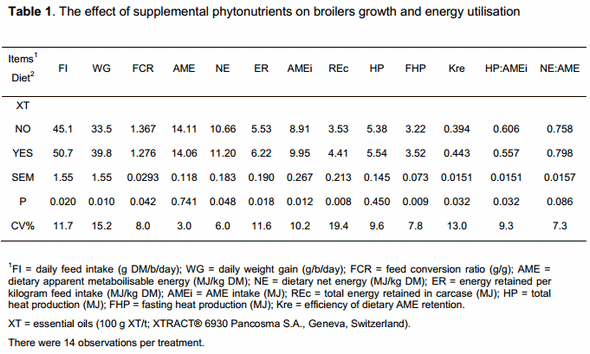Phytonutrients alter energy partitioning in poultry: the link with nutrition
Published: June 21, 2017
By: Pirgozliev V. 1, Rose S.P. 1, Bravo D. 2.
/ 1 The National Institute of Poultry Husbandry, Harper Adams University, England, TF10 8NB; 2 Pancosma S.A., Geneva, Switzerland.
Introduction
To prevent the risk of developing pathogens resistant to antibiotics and also to satisfy consumer demand for a food chain free of drugs, the use of in-feed antibiotics in the European Union was banned in January 2006, and this policy is being considered in other parts of the world. Consequently, the poultry industry seeks an alternative for antibiotics as growth promoters; one such alternative is the addition of phytonutrients to poultry diets (Bravo et al., 2014). The purpose of this paper is to describe the benefits of adding phytonutrients to poultry diets. The main focus is on evaluating the effect of phytonutrients on dietary energy partitioning in poultry.
Materials and methods
Birds were fed two mash diets in total. A control diet was prepared that had major ingredients of 528.6 g/kg maize and 313.0 g/kg soybean meal, and contained 215 g/kg crude protein and 12.13 MJ/kg metabolizable energy (ME). The diet was then split into two batches and one of them was supplemented with a commercial blend of phytogenic feed additives (supplemental plant extracts [XT]; XTRACT 6930; Pancosma S.A., Geneva, Switzerland) and comprising 5% carvacrol, 3% cinnamaldehyde, and 2% capsicum oleoresin at 100 g/t).
During the pre-study period, from day old to 7 d old, all birds were reared in a single floor pen and fed a standard chicken starter feed that did not contain any coccidiostat or antimicrobial growth promoters, prophylactics, or other similar additives.
On the first day of the experiment (7 d of age), chicks were individually weighed and allocated to individual pens with a solid floor (0.160 m2 floor area) that was covered with clean wood shavings. Each of the 2 experimental diets was offered to birds in 14 individual pens following randomisation. Room temperature and lighting regime met commercial recommendations (Aviagen Ltd., Edinburgh, UK). At 18 d of age, the solid floor of each pen was replaced with a wire mesh floor, and the total excreta output was collected until the end of the study. Feed intake (FI) for the same period was recorded for the determination of dietary ME. The total trial period was 14 d, and study ended when the birds were 21 d of age. All birds were weighed at the beginning (7 d old) and at the end (21 d old) of the study, and the weight gain (WG) and feed conversion ratio (FCR) were determined. At the end of the study, at 21 d old, all chickens were killed by cervical dislocation and the energy utilisation criteria was determined by comparative slaughter technique as previously described (Bravo et al., 2014). The fasting heat production (FHP MJ/bird) was estimated to be 0.450 MJ/d per kg of metabolic body weight (BW)0.70 per day, which correspond to the asymptotic heat production at zero activity, as proposed by Noblet et al. (2010). Data were statistically analysed with a randomized block ANOVA. In all instances, differences were reported as significant at P < 0.05.
Results and discussion
Birds fed phytonutrient had improved (P<0.05) daily FI, WG and FCR by 12.4, 18.8 and 6.7 %, respectively (Table 1). Although no changes (P>0.05) in ME were observed, the phytonutrient supplementation improved (P<0.05) dietary NE and RE by 5.1 and 12.5 %, respectively. The values for NE were similar to previous reports (Swick et al. 2013). Feeding phytonutrient also improved ME intake, carcass energy retention, efficiency of ME utilisation (Kre), and the total HP 2 to ME intake ratio (P<0.05), although there were no changes to total HP (P>0.05). The FHP of birds fed phytonutrient increased (P<0.05) possibly due to the relatively heavier weight of the birds (Rivera-Torres et al., 2010). Total heat production constituted 58% of the ME intake which is similar to values reported by van Milgen et al. (2001). The NE:ME ratio was similar to those reported by Swick et al. (2013) and tended (P<0.1) to be higher for the phytonutrient supplemented diet (P>0.05).
Dietary NE is the ME of the feed corrected for losses that result from the assimilation of dietary ingredients, frequently termed the heat increment of digestion. The remaining net energy is available for both maintenance and production. The improvement in feed efficiency in this report coupled with improved NE and ME intake, but not with ME. This also coupled with reduction of HP:AMEi, but not with HP alone. This suggests that supplementary phytonutrients may influence energy partitioning by reducing the maintenance needs of poultry, thus diverting more energy for growth / production. Usually, the benefits in performance and energy improvement when phytonutrients were fed to poultry have been attributed to changes in immune modulation and gut microflora proliferation and microbiome.

Conclusions
Dietary phytonutrients alter energy partitioning in broilers. Phytonutrients may maximise the nutritional value of feed without compromising the development of pathogens resistant to antibiotics. The mode of action of dietary phytonutrients is associated with improved use of available energy for production, and reduced maintenance needs of the birds.
Implications
Phytonutrients have a future use in poultry management systems and so reduce the use of antibiotics in poultry meat production.
Presented at CLANA 2016, Cancun, Mexico.
References
Bravo, D., Pirgozliev, V., Rose, S.P., 2014. A mixture of carvacrol, cinnamaldehyde and capsicum oleoresin improves energy utilization and growth performance of broiler chickens fed maize based diet. J. Anim. Sci. 92, 1531-1536.
Noblet, J., Dubois, S., Labussiere, E., Carré, van Milgen. J., 2010. Metabolic utilization of energy in monogastric animals and its implementation in net energy systems. In ‘Proceedings of the 3rd international symposium on energy and protein metabolism and nutrition, Parma Italy’. European Federation of Animal Science. (Ed. GM Crovetto) pp. 573–582. (Wageningen Academic Publishers: Wageningen, The Netherlands)
Rivera-Torres V., Noblet J., Dubois S., van Milgen J. 2010. Energy partitioning in male growingturkeys. Poult. Sci. 89:530–538.
Swick, R.A., Wu, S-B., Zuo, J., Rodgers, N., Barekatain, M.R., Choct, M., 2013. Implications and development of a net energy system for broilers. Anim. Prod. Sci. 53, 1231-1237. van Milgen, J., J. Noblet, S. Dubois, B. Carr, and H. Juin. 2001. Utilization of metabolizable energy in broilers. Poult. Sci. 80 (Suppl. 1):170 (Abstr.).
Content from the event:
Related topics:
Authors:
Nutreco
Recommend
Comment
Share
Recommend
Reply
Recommend
Reply

Would you like to discuss another topic? Create a new post to engage with experts in the community.











.jpg&w=3840&q=75)